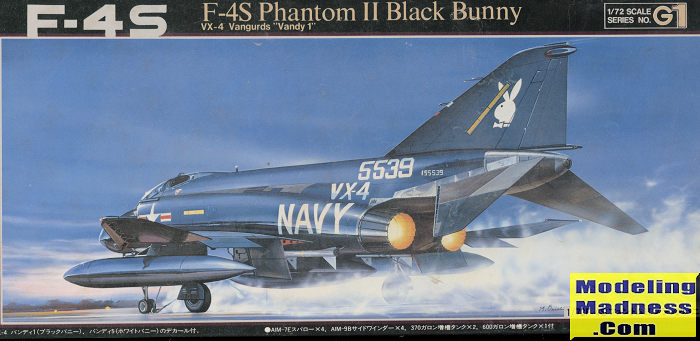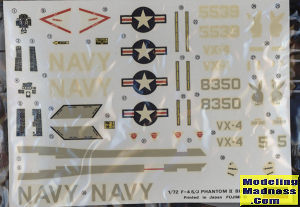
Fujimi 1/72 F-4S Phantom II
| KIT #: | 7AG1 |
| PRICE: | $10.00 'used' |
| DECALS: | Two options |
| REVIEWER: | Scott Van Aken |
| NOTES: | 1984 release |

| HISTORY |
The F-4S was the final naval variant of the F-4 Phantom, save for the later drone conversions, which didn't get a separate variation suffix. The S model was an upgraded F-4J that included ECM antennas on the intakes, 'smokeless' J-79 engines and some additional changes in avionics systems. It was the F-4S with which the Navy and Marine Corps retired their association with the Phantom II. While a few were converted to QF-4S drones and some went to museums, the majority of what was left were scrapped.
| THE KIT |
 The
first really well done F-4s in 1/72 were the Monogram versions of the C/D and J.
Sure, Revell, Hasegawa and Frog, among others, had done Phantoms in this scale,
but they were lacking in detail and many of them had shape issues. Not
unbuildable, but not that well done either. The Fujimi series was the first
semi-modern, engraved panel line series and while later overtaken by kits from
Hasegawa and Fine Molds, when they arrived on the scene in 1984 were most
welcomed by modelers. I know that I built at least ten of the various boxings of
this kit and it still makes into a very nice model.
The
first really well done F-4s in 1/72 were the Monogram versions of the C/D and J.
Sure, Revell, Hasegawa and Frog, among others, had done Phantoms in this scale,
but they were lacking in detail and many of them had shape issues. Not
unbuildable, but not that well done either. The Fujimi series was the first
semi-modern, engraved panel line series and while later overtaken by kits from
Hasegawa and Fine Molds, when they arrived on the scene in 1984 were most
welcomed by modelers. I know that I built at least ten of the various boxings of
this kit and it still makes into a very nice model.
Let us look at some of the positives and not so positives about the kit. First thing one builds is the interior. This is fairly basic as 1/72 jets goes and relies on decals for both the main instrument panels and the side consoles. No raised detail as on the Monogram kits. The seats are generic MB Mk.4 shapes with no real detail. The interior fits atop the lower forward fuselage section that includes the nose gear well. This is then trapped between the two fuselage halves. This is the first release and as with the first releases, the interior has issues when it comes to how it fits in the fuselage. Later boxings added bulkheads behind the pilot and RIO that this lacks and it does help. Oddly no one every produced a resin aftermarket interior, which would have sold very well.
With the halves together the intakes, which have no real trunking, are installed. Wings are next. These are the hard wings before the additional maneuvering slats were installed. In fact, I don't think the Mitsubishi built planes ever got that upgrade. Tailplanes are slotted, a feature that helped low speed handling. The kit also has a single piece canopy, which for me is not a big deal, but some like open canopies.
The kit
does have wing inserts for the spot where on Navy planes there is a cat strop
hookup. Holes will need to be opened for the slat extension fairings and for the
intake ECM antennas. Landing gear is well done. For the main gear, the builder will need to
cut apart the separate doors. The kit provides wing fuel tanks as well as the
proper USN style pylons for the Sidewinders. Sparrows are also included and like
the Sidewinders are not very detailed.

Instructions in my kit are in Japanese and English, the well done drawings are a good building guide. Especially if you have built a lot of these. Colors have Gunze paint numbers. The sheet provides options for both the white bunny and black bunny from VX-1, though the markings are yellowing. I'd also test a marking not used to ensure they are still viable. Fortunately there is no problem finding aftermarket sheets for this if you wish to go that route.
| CONCLUSIONS |
If you want a fairly quick build and don't have a ton of money to spend, I can recommend looking for one of these Fujimi kits either at a show or various on-line auctions as those people on e-bay are asking ridiculous prices for the kit.
February 2025
Copyright ModelingMadness.com. All rights reserved. No reproduction in part or in whole without express permission.
If you would like your product reviewed fairly and fairly quickly, please contact the editor or see other details in the Note to Contributors.